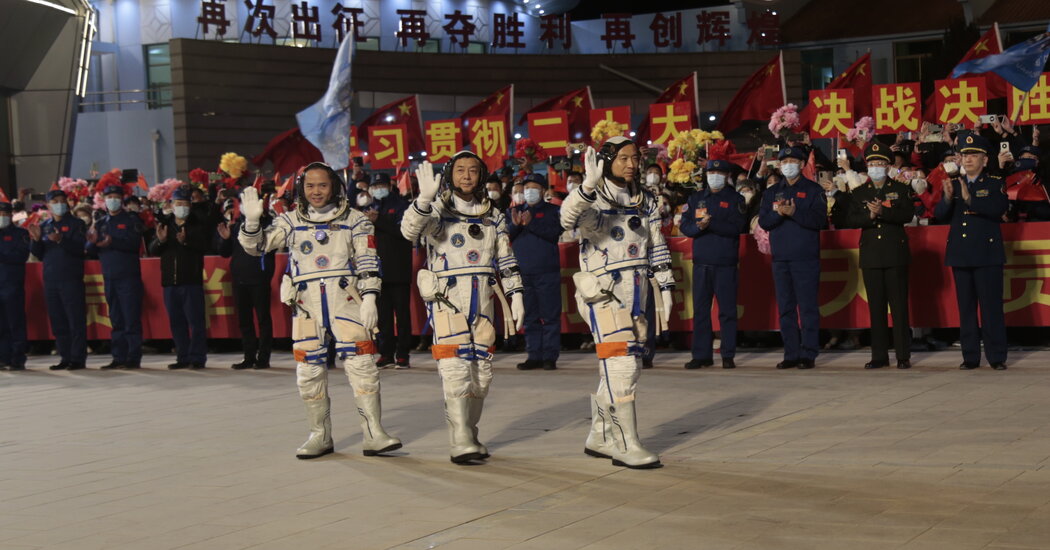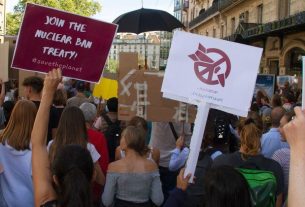China’s marathon race in space
Instead of running a head-to-head space race against the U.S., China has set off on a marathon. It’s making good time.
In late October, China completed the assembly of its Tiangong space station. Late last month, three Chinese astronauts took off from the Jiuquan Satellite Launch Center and landed at the space station, beginning the permanent occupancy of the outpost.
These achievements, combined with recent probes to the moon and Mars, show China’s growing success. My colleague Keith Bradsher made a rare foreign visit to a desert rocket base in Jiuquan, where senior space officials described plans for a new space station and reusable rockets.
They also discussed ambitions to travel beyond near-Earth orbit and put astronauts on the moon. And they outlined an even bigger prize: sending humans to Mars.
Analysis: Seeking to burnish its prestige in the world, China is portraying Tiangong as a space station for scientists everywhere, especially in countries without established space programs.
History: Here’s a timeline of China’s advancements in spaceflight.
Reaction: In August, the U.S. predicted that China would surpass its space capabilities by 2045.
China’s Covid plan: More shots
China has launched an all-out campaign to convince older citizens that its latest Covid-19 vaccines are easy to take and effective.
The vaccine is inhaled instead of injected, which could reduce the fear of a needle prick. In state-run media, one woman quipped that getting her booster was “a bit like drinking milk tea.” A man in Wenzhou reassured the hesitant that “it doesn’t hurt at all, and it’s a little sweet.”
Understand What Is Happening in China
The campaign is critical. As China drops its restrictions after protests, it’s bracing for a surge in cases that could overwhelm its medical resources. The deadliness of coming outbreaks depends in part on whether older adults are willing to be inoculated.
But officials also have to overcome a deeply ingrained skepticism, which they helped instill. In early 2021, when China introduced its domestic vaccine, regulators restricted use to people between the ages of 18 to 59. That made many people think it was unsafe for older adults.
China’s vaccines are also usually less effective than foreign mRNA vaccines, and little is known about the real-world efficacy of the inhaled treatment.
Other challenges: Health experts, looking at the precedents set by Hong Kong and Singapore, have also warned that the campaign might be too late to defend against the current wave of cases. Within China’s oldest segment of the population, 40 percent have not received a booster.
Details: China also plans to deactivate its Covid-19 app today, CNN reports. The app has governed daily life for years, dictating people’s movements. The government may have used the app to quash dissent.
Japan’s push for India’s tech talent
Japan faces a dearth of IT engineers, and India produces 1.5 million engineering graduates each year. But Japan is having a hard time recruiting highly educated Indians when opportunities in the U.S. and Europe beckon.
Japan desperately needs more workers as its population ages. In the tech sector alone, the government estimates that the shortfall in workers will reach nearly 800,000 in the coming years as Japan pursues a long-overdue national digitization effort.
But even though the country has tried to attract foreign workers and recruit tech talent in India, it faces steep challenges. Lower pay, rigid corporate hierarchies and steep language barriers make Japan a less attractive option. In the U.S., for instance, average tech salaries are more than twice as much as those in Japan.
Culture: Japan’s ambivalence toward foreigners means the country does not have an established way to integrate them into society.
Tech: Japan, the world’s third-largest economy, has struggled to transition from physical paperwork to digital tools. Japanese companies’ use of cloud technologies is nearly a decade behind those in the U.S.
THE LATEST NEWS
Asia Pacific
Times Styles writers and editors have selected their 93 most stylish “people” of 2022.
Not everything on the list is a person. There are nonhumans, like the spotted lanternfly and the James Webb Space Telescope. There are movie characters, like Lydia Tár. And, of course, Beyoncé makes the cut.
ARTS AND IDEAS
Drilling, and heritage
The Burrup Peninsula on Australia’s northwest coast could be a key spot for Australia’s mining push. A major liquefied natural gas project is set to supercharge drilling off the coast, and plants will be built to process it.
But the peninsula, called Murujuga by Aboriginal people, is also home to a million petroglyphs believed to be up to 50,000 years old. They document extinct animals and include some of the oldest depictions of the human face.
Indigenous Australians fear that the new construction will threaten sacred heritage sites. The project will be one of Australia’s most polluting developments, progressive research institutes and experts say — it could release almost 1.8 billion tons of emissions. Indigenous leaders say they have few options; they can only negotiate terms, not veto projects.
“We don’t have the voice to say no,” one Indigenous man told The Times. “We legally don’t.”



